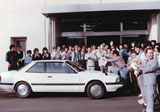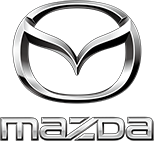Capella(1970~)
Capella Part 2: (Fourth- to fifth-generation models)
Fourth-generation wins the battle for front-wheel drive
The fourth-generation Capella was launched in September 1982. Breaking away from its front-engine rear-wheel drive (FR) predecessors, the fourth-generation model was released with a new front-engine front-wheel drive (FF) platform. At the time of development, FR setups were the norm, and management was reluctant to switch to an FF drivetrain. In a climate of severe operating conditions, and with Mazda already expending resources on the construction of a new plant (Hofu) as well as a great deal of capital investment, some questioned the necessity of taking on the FF challenge. Others thought that the FR arrangement was better, especially in view of Mazda's focus on handling. Nevertheless, the research and development team - who stressed comfort and convenience as well as reduced vehicle weight - responded to management concerns: "In the coming age of front-engine front-wheel drive vehicles, we will lose ground to other automakers if we don't build an FF model." They continued to push for front-wheel drive, and their persistence finally paid off with the launch of the first front-wheel drive Capella.
The powertrain used a newly developed engine nicknamed the "Magnum" that featured reshaped combustion chambers and intake ports. Mazda's engineers also succeeded in reducing engine weight by as much as 26 kilograms compared with the previous generation. The television commercials featured famous French actor Alain Delon, which undoubtedly stirred up considerable interest, and the Capella won Mazda's third Japanese Car of the Year award. Within the first year of the Hofu plant becoming operational, full-scale Capella production was implemented, and the plant was soon rolling out 300,000 units a year. But even this was not enough to respond to all the market demand. In Europe, Mazda presented a golden cow*1 ornament to every customer who was awaiting delivery of a Capella, bringing the car further attention as a well-known, even legendary, model.
Fifth-generation Capella: the continued pursuit of new technology
The fifth-generation Capella debuted in 1987. Developed to achieve linear dynamic performance, the car adopted the world's first speed-dependent foar-wheel steering(4WS). The Capella was available with the first mass production diesel engine to feature a pressure wave supercharger, full time 4WD and a host of other new technologies. Mazda was especially concerned about the quality of the Capella's 4WS system, and stringently inspected every unit. In 1988, Mazda added a seven-seat station wagon variant called the Capella Cargo. To heighten the passenger car appearance, Mazda collaborated with a supplier to reshape the smoothly curved rear window until the ideal look was achieved. The Capella Cargo earned praise as the best-designed station wagon of the period.

Celebrating the Japanese Car of the Year Award in front of the Design Center
The fifth-generation model played an important role in expanding Mazda's business overseas. In the US, the company completed construction of the MMUC (now AAI) plant, which began operations by building the fifth-generation Capella*2. Favourable sales contributed to a further boost in the plant's production.
In Germany, the Capella was repeatedly selected for the Reader's Choice Import Car of the Year award by Auto Motor und Sport magazine. The vehicle's success in Germany caused amazement in Japan, and study tours were organized for Japan's domestic car dealers. Participants were genuinely surprised to see so many Capellas running on German roads.
*1: In Europe, the golden cow is a symbol of something unobtainable.
*2: Named MX-6 in the US.

